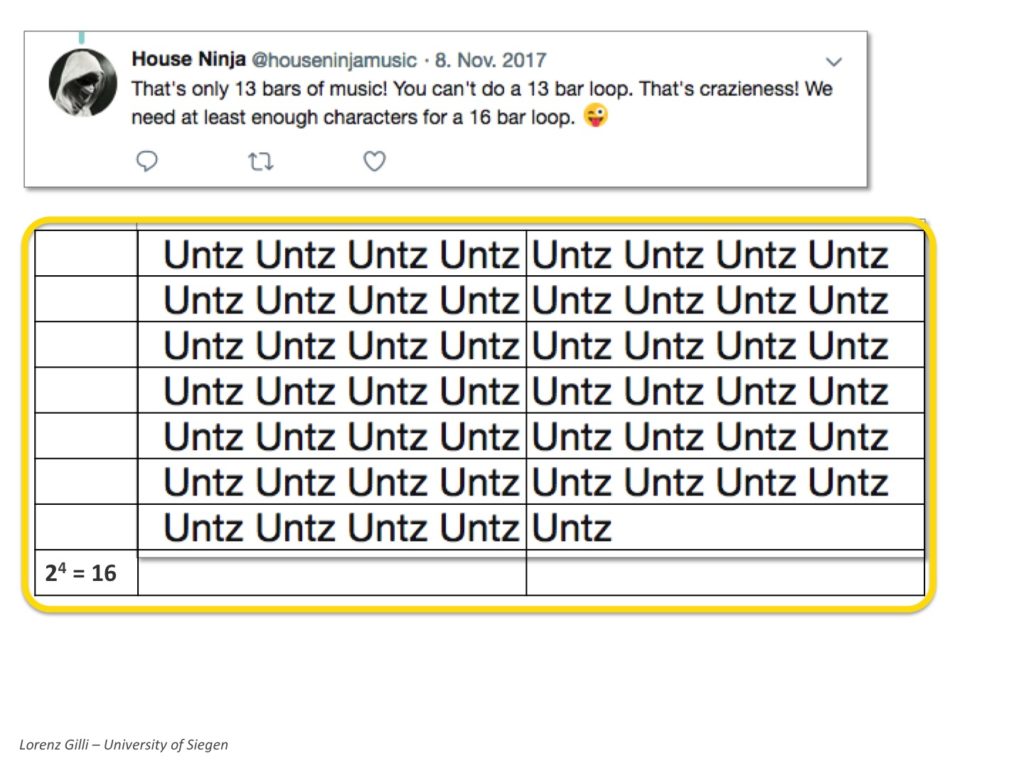thanks to twitter-users @mixmag, @mixvibes, @f0la_, @Ltm67 and @houseninjamusic for their tweets!
Two days ago, on friday, April 26 2019, I held a presentation on repetition in EDM and in DJ-sets at the conference „Again & Again. Musical Repetiton in Aesthetics, Analysis and Experience“ at City, University of London Music Department, . In that presentation, I used tweets by the aforementioned users – that’s why I’d like to thank those users this way and give a brief synopsis of how I used those tweets and what insights they gave me (and hopefully, to the audience of my presentation).
I started with this tweet by @mixmag, because it already demonstrates a few important aspects: first, that repetition in EDM is referred to directly and with a tongue-in-cheek-attitude by people form the scene(s). Secondly, that repetitive beats are described in a onomatopoeic manner by simply naming the phenomena as it sounds: UNTZ. No theorizing or describing, but the pure sounding impact of the basic rhythm-pattern (kick-drum and hi-hat) is mimicked.
The following answers to this tweet I used to exemplify the breadth, in which repetition is thematized within the EDM-culture: rhythmically, vocally/in the lyrics and as a repetitive raving lifestyle.
The follwing answer I used to show more in detail how repetition takes place in EDM:

Here’s an excerpt of my script on that topic:
With this post, they point out that repetition in electronic dance music not only take place in a constant flow of repeated auditory events – like the kickdrum and hi-hat – but that it is also grounded in the looped repetition of patterns of equal length. In fact, musicologist Mark J. Butler states that EDM is based in almost all cases on a 4/4 meter, often with a kick drum on all 4 quarters – the so-called “four to the floor” pattern in disco, house, techno and trance music. A few of these bars in 4/4 meter are then combined to musical patterns, which are then extensively repeated throughout a single EDM-track. The length of these patterns however is not arbitrary. In fact, the length shows mathematical characteristics similar to repetition. Its length is based on the power of a single prime integer, in this case on the single prime integer “2”. Following music theorist Richard Cohn, Butler calls them “pure duple”. The length of these musical patterns composed and then repeated – looped – is therefore, in most cases, a power of two: 2, 4, 8, 16 (as in House Ninja’s tweet) or 32.
The complete track is then organised along these patterns: changes in the musical texture are achieved by alternating or muting individual layers, or by arranging them in the grid provided by a digital audio workstation on its graphical user interface. Most often, the changes occur either at the beginning or at the end of each pattern. Patterns that are not pure duple, for example those with a length of 12 or 24 bars, can also occur: being both even and a multiple of four, they show similar repetitive characteristics to the pure-duple patterns. Other loop lengths that are not multiples of four – like 6, 10 or 14 – occur seldomly. And odd lengths like 13 are simply “crazieness” (sic!), to quote House Ninja’s tweet.
Luckily and thanks to the twitter-layout, the original Mixmag-tweet was arranged in a way that every line contained exactly 8 times ‚UNTZ‘, which allowed my to visualize the pure-duple loops and House Ninja’s comment in visually appealing and perfectly fitting way:

After this introduction where I could make clear, on which levels and by which aestethic principles repetition in EDM takes place, I went on in elaborating differences of repetition between funk and EDM, pointing to the importance that small variations are emphasized in analysis of funk-music, like Anne Danielsen in her work on James Brown’s „Funky Drummer“. Contrary to that, EDM takes advantage of ‚exact‘ repetition by repeating exactly the same stretches of sound. In this way, listeners can perceive and explore these repeated sounds in more detail and are allowed to create their own „unique sonic pathways“ (L.–M. Garcia), and differen types of pleasure as well as effects of ‚flow‘ and ‚groove‘ (W. Trost) can arise (of course, EDM-producer also apply small variations in timing or timbre, gradual changes in texture by applying effects, filter etc. on repeated loops – but this was not my core point in this presentation). Finally, I used my analytical framework consisting of three aesthetic principles that DJs use in order to conceptualize and perform their sets to demonstrate, how repetition in EDM is used, created or expanded by DJs. The three principles are:
- ‘repetition’, which primarily refers to looping musical patterns or fragments,
- ‘modulation’, by which I mean variation of the sound and sonic texture,
- ‘combination’, which means combining two or more material sonic entities, either sequentially or in parallel.
As this was a conference on repetition, I focussed on that: first by adressing repetition in its pure form, as hip hop-DJs like Kool Herc or Grandmaster Flash developed with breakbeating. Then I gave an example for each, how repetition can be combined with the other two (modulation: by applying effects, and combination: when phrasing a mix) and finally how all three of them can be combined: by looping and applying effects on the tracks that is about to end while mixing it with the new track in the transistion, hence extending the transition and making it much smoother.




